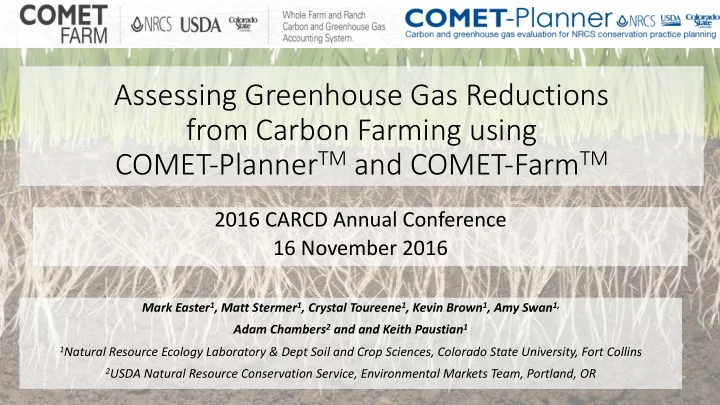

Assessing Greenhouse Gas Reductions from Carbon Farming using COMET-Planner TM and COMET-Farm TM 2016 CARCD Annual Conference 16 November 2016 Mark Easter 1 , Matt Stermer 1 , Crystal Toureene 1 , Kevin Brown 1 , Amy Swan 1, Adam Chambers 2 and and Keith Paustian 1 1 Natural Resource Ecology Laboratory & Dept Soil and Crop Sciences, Colorado State University, Fort Collins 2 USDA Natural Resource Conservation Service, Environmental Markets Team, Portland, OR
Acknowledgements • This work is supported by the following organizations: • Rathmann Family Foundation • Marin Carbon Project • Jena and Michael King Foundation • USDA Natural Resources Conservation Service • USDA Climate Change Program Office.
Outline • Brief Description of COMET-Planner TM and COMET-Farm TM • Modeling Carbon Farming in the COMET Tools • Adding cover crops to cropland • Adding legumes to pasture or rangeland • Adding compost to cropland • Adding windbreaks to cropland, pasture or rangeland • Q&A
A Brief Description of COMET-Planner TM and COMET-Farm TM
COMET-Farm™ & COMET-Planner™ Greenhouse Gases in Agriculture The COMET Tools Provide a Systems Approach to GHG Inventories and Conservation Scenario Analysis Image courtesy of Amy Swan of the NREL at Colorado State University
COMET-Farm™ & COMET-Planner™ Calculation Methods Implements the peer-reviewed, USDA- • sanctioned entity-level inventory methods. • Soil-related GHG emissions: DayCent dynamic model, also used in the U.S. National Greenhouse Gas Inventory. • Livestock-related GHG emissions: statistical models based on USDA and university research, largely consistent with models used in the U.S. National Inventory. • Energy-related GHG emissions: based on the models used in the USDA/NRCS Energy Tool along with supplemental peer-reviewed research results.
COMET-Farm™ How it works Web Interface User inputs their unique Farm or Ranch management. Specific Specific Activities Location Results CSU Server Climate & Soil NARR & Outputs Historic SSURGO Rotations NRI, Cropping Equation Practices Survey, Factors, CSRA Empirical USDA Methods, Models IPCC
COMET-Planner™ How it works Web Interface User selects State and County User selects NRCS CPS to apply. of their farm or ranch. Generalized Conservation Region Practices Average Mitigation Effect CSU Server Climate & Soil NARR & Outputs SSURGO Historic Rotations NRI, Cropping Practices Equation Survey, Factors, CSRA Empirical USDA Methods, Models IPCC
COMET-Farm TM & COMET-Planner TM Conservation Scenario Analysis Change in Management } COMET-Farm TM Tillage Reduction Compare Cropland Baseline Benefits on the Improved Scenario Same Fertilizer (Business as Usual) Balance Sheet Management (Current Management) Add Cover Crops COMET-Planner TM = Practice Conservation Business as Usual Benefit Practice
COMET-Farm TM & COMET-Planner TM GHG Mitigation Effects Every 1% increase in organic matter on 160 acres with a 8 inches } silt-loam soil equals ~ 900 (20 cm) metric tonnes CO2e. This equals removing the emissions from ~190 passenger vehicles for 1 year. Photo courtesy of the USDA-NRCS
COMET-Farm TM & COMET-Planner TM Further Resources On-Demand Training Videos available on covering all COMET-Farm TM modules and the COMET-Planner TM tool. Live Webinars on COMET-Farm TM and COMET-Planner TM available through 2016. The training schedule can be found on the COMET-Farm TM ‘Help” page. If you would like to request a training for you or your group contact Matthew Stermer. Matthew.Stermer@colostate.edu Stay updated by following us on & or
Modeling Carbon Farming in COMET-Planner TM and COMET-Farm TM • Cropland and grassland in Merced County featured in this analysis. • Results from COMET-Planner TM and COMET-Farm TM are both shown. • This is NOT a model comparison exercise! • Results from both tools illustrate the effects of regional variability in soils, climate and cropping practices. • COMET-Planner TM : Use for Project Planning • COMET-Farm TM : Use for Field & Pasture-level Verification
Adding Cover Crops to Cropland
Add Cover Crops to Cropland COMET-Farm TM -0.34 Mg CO 2 e/acre (4 fields near Merced) --------------- Current COMET-Planner TM -0.25 Mg CO 2 e/acre Updated COMET-Planner TM -0.20 Mg CO 2 e/acre (100 fields – Central Valley)
Adding Legumes to Pasture or Rangeland
Add Legumes to Pasture or Rangeland COMET-Farm TM -0.60 Mg CO 2 e/acre (4 fields near Merced) --------------- Current COMET-Planner TM -0.35 Mg CO 2 e/acre Updated COMET-Planner TM 0.003 Mg CO 2 e/acre (100 fields – Central Valley)
Adding Compost to Cropland
Add Compost to Cropland COMET-Farm TM example -0.89 Mg CO 2 e/acre (cropland) (4 fields near Merced) --------------- Current COMET-Planner TM -1.0 Mg CO 2 e/acre (cropland) Updated COMET-Planner TM -.725 Mg CO 2 e/acre (100 fields - Central Valley)
Adding Windbreaks to Cropland, Pasture or Rangeland
Add Windbreaks to Cropland, Pasture or Rangeland COMET-Farm TM -4.3 Mg CO 2 e/acre --------------- Current COMET-Planner TM -1.1 Mg CO 2 e/acre Updated COMET-Planner TM -4.3 Mg CO 2 e/acre
Conclusions • This was NOT a model comparison exercise! • Results from both tools illustrate the effects of regional variability in soils, climate and cropping practices. • Use COMET-Planner TM for Project Planning • Use COMET-Farm TM for Field & Pasture-level Verification • Weekly training webinars available in each of the COMET Modules • URLS www.comet-farm.com www.comet-planner.com
Thank You www.comet-farm.com www.comet-planner.com
COMET-Farm TM & COMET-Planner TM Further Resources On-Demand Training Videos available on covering all COMET-Farm TM modules and the COMET-Planner TM tool. Live Webinars on COMET-Farm TM and COMET-Planner TM available through 2016. The training schedule can be found on the COMET-Farm TM ‘Help” page. If you would like to request a training for you or your group contact Matthew Stermer. Matthew.Stermer@colostate.edu Stay updated by following us on & or
Recommend
More recommend